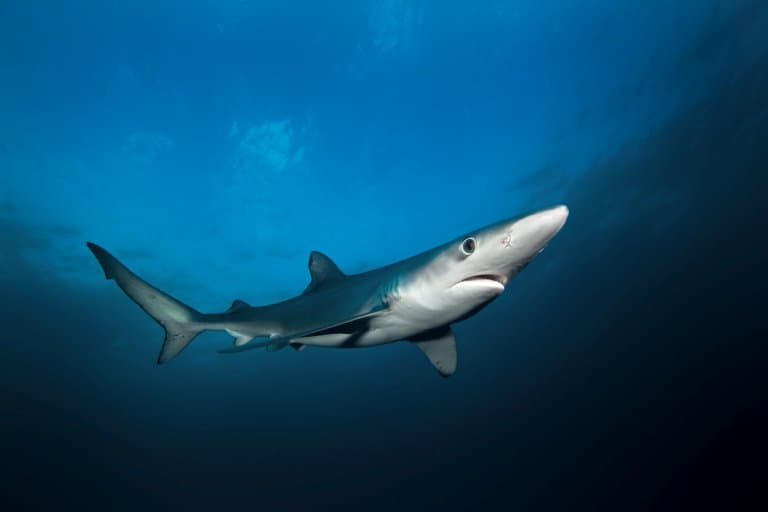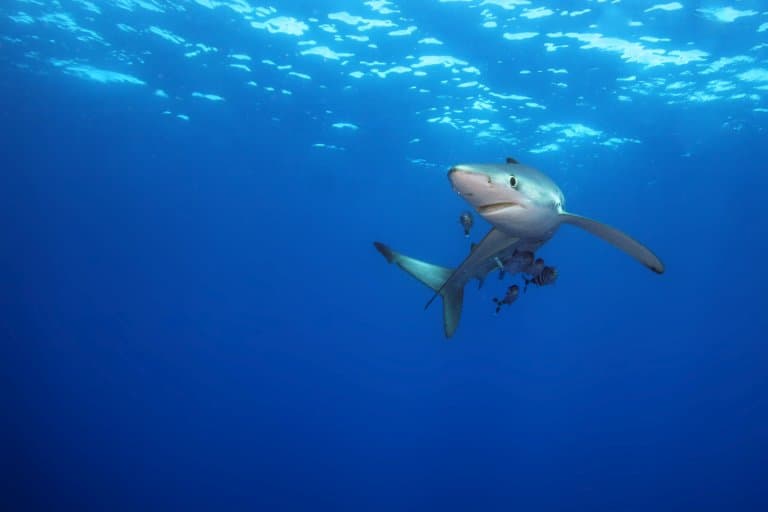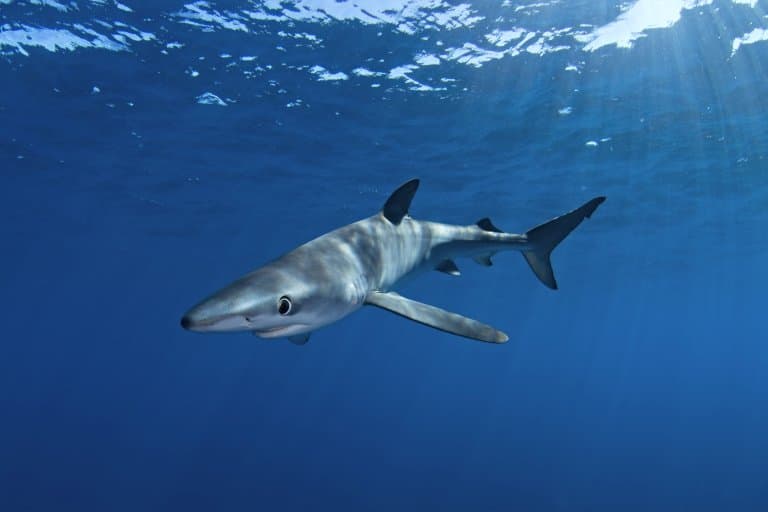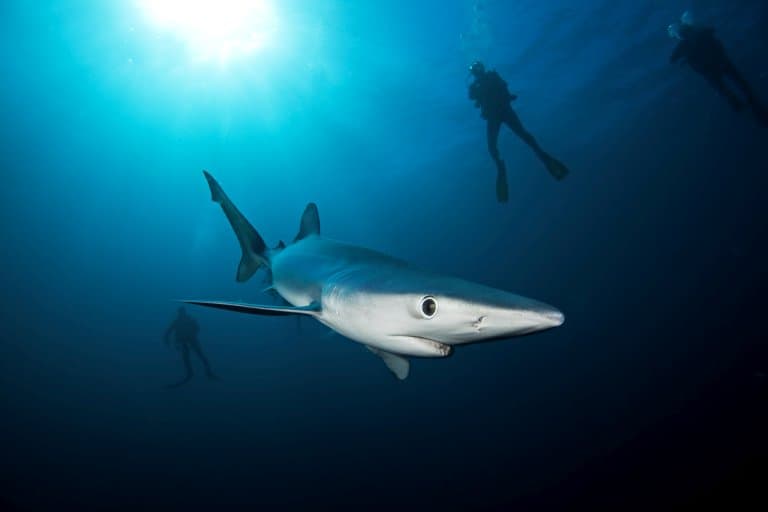Blue Shark Profile
The blue shark is a large, predatory species of open-ocean (pelagic) shark found in deep temperate and cool tropical waters around the world.
They are slender and torpedo-shaped with a pointed conical snout and large round eyes.
They are recognisable by their long front (pectoral) fins, and they have an elongated tail fin (caudal fin) which helps with swimming: providing power as it moves from side to side. Blue sharks are also identified by very sharp, saw-edged teeth.

Blue Shark Facts Overview
| Habitat: | Deep waters in temperate/tropical oceans |
| Location: | Worldwide |
| Lifespan: | 15 to 20 years in the wild, only around 8 years in captivity |
| Size: | 3 m on average, but up to 4 m (13 ft) in length |
| Weight: | Up to 200kg |
| Color: | Iridescent blue, white |
| Diet: | Small fish, squid, small sharks, seabirds |
| Predators: | Great white shark, tiger shark, orca, sea lions |
| No. of Species: | 1 |
| Conservation Status: | Near Threatened |
Blue sharks are large in size: usually around 3m, although some can grow bigger, even up to 4m (13 feet) in length, and weigh up to a hefty 200kg. They came 9th in our biggest sharks in the world list.
They get their name from the beautiful, metallic blue shade on their backs, which provides excellent camouflage in deep waters. They are only blue on top, however, and are fully white on their underneath side and belly.
Blue sharks are most active in early evening and at night; they move inshore during these times in search of prey. They can often be seen cruising at the water’s surface with their fin tips above the surface, but they will also swim and dive to depths of 350m or more when searching for prey.
They feed mainly on squid, other fish, as well as crustaceans, or the occasional seabird, and have been known to eat bottom-feeders too.
Being smaller than other toothy sharks, they’re also a food item themselves. They make up for this by being quite reproductive, and able to produce well over 100 pups in a single litter. Blue sharks reproduce through internal fertilisation and pups are born after a 9-12 month gestational period. Young blue sharks are around 35-50cm at birth and become independent quickly.
They are not hunted for food as they have a fairly bland taste, but nevertheless, they are hunted for their fins in the illegal finning trade, and as fishing bycatch.
Interesting Blue Shark Facts
1. Blue sharks give birth to live young
Unlike other marine life, sharks give birth to live young rather than eggs. Fertilised eggs remain in the mother’s womb and are nourished by a yolk-sac, which acts a bit like a placenta.
On average, a female shark will give birth to around 35 young sharks (pups) per litter, however the litters can be much larger – even up to 100 pups or more at one time. The largest litter ever recorded was 135 pups. 1

2. Blue sharks migrate long distances during the year
In the Atlantic Ocean, blue sharks are observed to travel a generally clockwise route from the Caribbean up to the UK following the Gulf Stream.
After the summer months, they return to the Caribbean using the Atlantic North Equatorial Current.
Pacific blue sharks have been known to migrate up to 92,00km annually. 2
3. Big shark, small meal
Despite the fact that an adult blue shark can reach lengths of over 3 metres, they specialise in small prey – feeding primarily on small fish, and small squid.
This is somewhat surprising considering their size, as other smaller sharks will often tackle larger prey.
4. Blue sharks use their huge fins to ride currents
Blue sharks are known for the incredibly long distances they migrate each year, searching for dense feeding grounds and the chance to mate.
However, experts believe that they are able to travel these long distances by using their long pectoral fins to ride ocean currents. They are the largest relative to its size of any shark.
This helps them to conserve energy, and also helps to explain why their migratory paths always follow the path of deep ocean currents.

5. Female blue sharks have thicker skins
The reason for this is to protect themselves from the male blue sharks, who often savagely bite the females during mating! Their thick skin prevents injury during this aggressive copulation. 3
6. Male and female blue sharks live in different places for most of the year
The two sexes remain separate from one another and often live in different areas except for mating season when they briefly come together for reproduction.
Blue sharks also tend to segregate by age and reproductive phase, forming groups with similar maturity levels as well as with the same sex.
7. Blue sharks have a very wide distribution
In fact, they are one of the most widely geographically distributed of all shark species and can be found almost everywhere in the world – from northern Norway to southern Chile.
Their wide reach and large populations meant that they were at one point the most common pelagic shark on earth. However, they are now threatened by commercial fishing, net entanglement and also illegal hunting for their large fins.
Due to their varied distribution and migratory tendencies, the IUCN reports them as native to 150 countries. Only places they are not found is arctic and polar regions. 4

8. Blue sharks live in groups called schools
Joining together to hunt and to migrate, blue sharks co-exist in quite large gender-based schools – either male or female groups.
Each group is generally led by the largest shark.
9. Blue sharks have been nicknamed ‘wolves of the sea’
This is due to their pack-like nature whereby they join together in hierarchical groups and exhibit aggressive behaviours while together.
10. Blue sharks have a sensory organ that can track an electromagnetic pulse
This is true of all sharks, who have electroreceptors called Ampullae of Lorenzini based around the nose.
These sense organs can pick up electromagnetic fields and are used to track and hunt prey by following their electromagnetic pulse. 5
11. Blue sharks are some of the most docile sharks
Despite their size, blue sharks are quite timid and have a relatively small history of attacks on humans – much lower than some other shark species.
There are in fact fewer than 20 recorded cases of attacks on humans by blue sharks. However, they can cause harm due to their large and jagged-edged teeth. 6
12. They are near threatened
They are classified as near threatened by the IUCN, due to an estimated decline in population size of around 20% over the last 3 generations due to fishing, both as a target and as a bycatch.
The blue shark is highly valued by big-game recreational fishers, and although many practice catch and release, recreational fishing can also be a threat due to post-release mortality.
Blue Shark Fact-File Summary
Scientific Classification
| Kingdom: | Animalia |
| Phylum: | Chordata |
| Class: | Chondrichthyes |
| Order: | Carcharhiniformes |
| Family: | Carcharhinidae |
| Genus: | Prionace |
| Species Name: |
Prionace Glauca |
Fact Sources & References
- “Blue Shark Facts & Information Guide”, American Oceans.
- “Blue shark – Prionace glauca”, Shark Research Institute.
- “Blue Shark”, British Sea Fishing.
- “Blue Sharks”, MarineBio.
- “Blue Shark”, North Wales Wildlife Trust.
- Mark McGrouther (2021), “Blue Shark, Prionace glauca (Linnaeus, 1758)”, Australian Museum.
